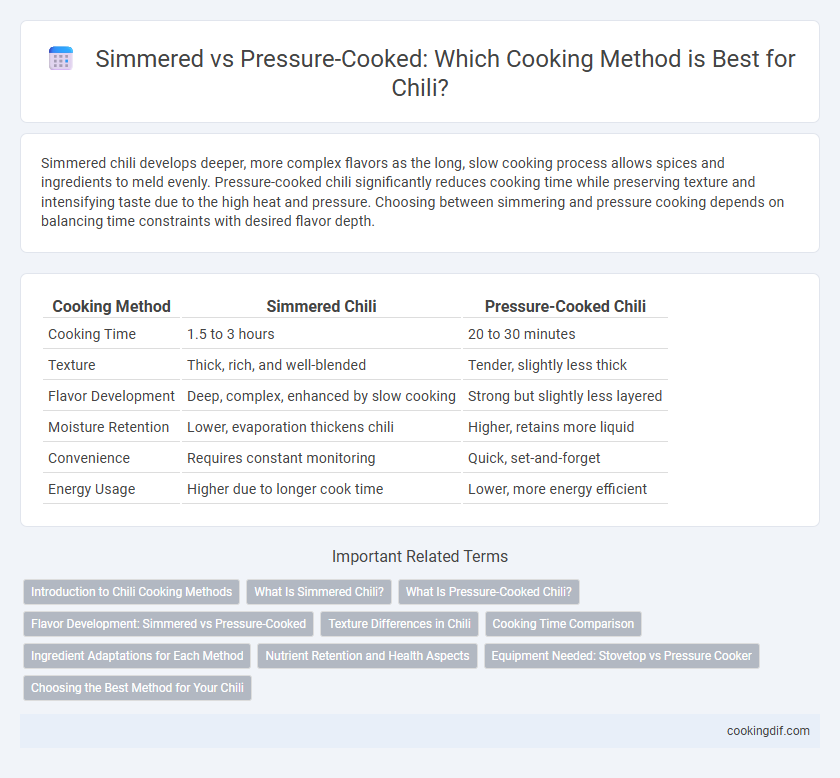Simmered chili develops deeper, more complex flavors as the long, slow cooking process allows spices and ingredients to meld evenly. Pressure-cooked chili significantly reduces cooking time while preserving texture and intensifying taste due to the high heat and pressure. Choosing between simmering and pressure cooking depends on balancing time constraints with desired flavor depth.
Table of Comparison
| Cooking Method | Simmered Chili | Pressure-Cooked Chili |
|---|---|---|
| Cooking Time | 1.5 to 3 hours | 20 to 30 minutes |
| Texture | Thick, rich, and well-blended | Tender, slightly less thick |
| Flavor Development | Deep, complex, enhanced by slow cooking | Strong but slightly less layered |
| Moisture Retention | Lower, evaporation thickens chili | Higher, retains more liquid |
| Convenience | Requires constant monitoring | Quick, set-and-forget |
| Energy Usage | Higher due to longer cook time | Lower, more energy efficient |
Introduction to Chili Cooking Methods
Simmered chili develops deep, complex flavors through long, slow cooking that tenderizes meat and melds spices evenly. Pressure-cooked chili significantly reduces cooking time by using high steam pressure to break down tough cuts quickly while preserving moisture. Both methods influence texture and taste, with simmering enhancing richness and pressure cooking offering convenience without sacrificing flavor.
What Is Simmered Chili?
Simmered chili is a cooking method where chili is slowly cooked over low heat for an extended period, allowing flavors to meld and ingredients to tenderize gradually. This technique ensures a rich, deep flavor profile as spices and meats break down and infuse the sauce evenly. Unlike pressure cooking, simmering avoids high heat and rapid cooking, preserving texture and enhancing the chili's complexity.
What Is Pressure-Cooked Chili?
Pressure-cooked chili involves using a pressure cooker to rapidly cook the ingredients under high pressure, significantly reducing the cooking time while intensifying the flavors. This method allows tougher cuts of meat and dried beans to become tender without long simmering periods, preserving moisture and enhancing the chili's richness. The high-pressure environment also helps meld spices and ingredients more thoroughly, resulting in a robust and deeply flavored chili.
Flavor Development: Simmered vs Pressure-Cooked
Simmering chili over low heat allows complex flavors to develop gradually as ingredients meld, intensifying the depth and richness. Pressure cooking shortens the cooking time significantly but may result in a slightly less nuanced flavor profile due to rapid cooking. The slow simmering method enhances aromatic compounds and tenderizes meat more effectively, promoting a robust and layered taste.
Texture Differences in Chili
Simmered chili develops a deep, rich texture with tender chunks of meat and softened beans, allowing flavors to meld gradually over time. Pressure-cooked chili produces a slightly softer texture, breaking down meat fibers quickly and creating a more uniform, stew-like consistency. The choice between methods affects the mouthfeel, with simmering offering a heartier bite and pressure cooking delivering a smoother, quicker meal.
Cooking Time Comparison
Simmered chili typically requires 1.5 to 3 hours to allow flavors to fully develop and meats to tenderize, resulting in a rich, slow-cooked taste. Pressure-cooked chili significantly reduces the cooking time to about 30 to 45 minutes by using high steam pressure to quickly break down ingredients while preserving flavor intensity. Choosing pressure cooking can save 70-80% of time compared to traditional simmering without compromising the depth of flavor.
Ingredient Adaptations for Each Method
Simmered chili requires longer cooking times to develop deep flavors, making it ideal for tougher cuts of meat and dried beans that absorb liquid slowly. Pressure-cooked chili uses high pressure to tenderize ingredients faster, allowing the use of quicker-cooking beans and leaner meats without sacrificing texture. Adjustments such as reducing liquid volume and adding delicate vegetables later in the process optimize ingredient integrity in pressure cooking.
Nutrient Retention and Health Aspects
Simmered chili retains more water-soluble vitamins such as vitamin C and some B vitamins due to the gentler cooking process, which prevents nutrient degradation. Pressure cooking significantly reduces cooking time, preserving heat-sensitive nutrients and enhancing the bioavailability of minerals like iron and zinc. Health-wise, both methods reduce harmful compounds, but pressure cooking better retains antioxidants and phytochemicals that support overall wellness.
Equipment Needed: Stovetop vs Pressure Cooker
Simmered chili requires a stovetop pot or Dutch oven to maintain a low, steady heat for several hours, allowing flavors to fully develop. Pressure-cooked chili uses a pressure cooker, which traps steam to cook the ingredients quickly under high pressure, significantly reducing cooking time. While stovetop methods need consistent temperature control, pressure cookers offer convenience and efficiency, making them ideal for faster meal preparation.
Choosing the Best Method for Your Chili
Simmered chili allows flavors to develop gradually, enhancing the depth and richness of the dish through slow heat over an extended period, making it ideal for beef and bean combinations. Pressure-cooked chili reduces cooking time significantly while tenderizing tough cuts of meat quickly and locking in moisture, which is perfect when time is limited. Choosing the best method depends on whether you prioritize flavor complexity via simmering or efficiency and tenderness through pressure cooking.
Simmered vs Pressure-Cooked for cooking method Infographic

 cookingdif.com
cookingdif.com